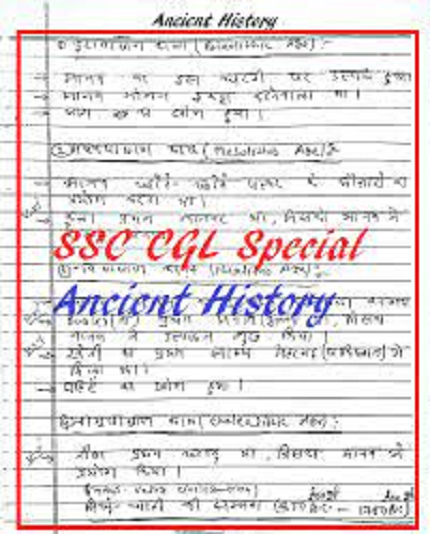Modern History of Indian Handwritten Notes in English PDF for free download. Coaching Class hand written notes of Modern History, useful for UPSC Pre and Mains, SSC CGL CHSL, CPO, NRA CET, UPSSSC, UPPSC, and other Govt Jobs Competitive Exams. We are going to share one of the best handwritten Coaching Class Notes of Modern History.
Ancient Indian history
Pre-Harappan cultures and Indus valley civilization: origin, important of town planning, trade, and commerce, the downfall
No.-1.Famous towns of ancient India
No.-2.Chronology of important events
No.-3.Age of maha Jana padas
No.-4.Ancient India rules and important Kingdoms, Magadh, Maurya, Shunga, Kanva, Andhra Satavahana, Kushana, Gupta, Vardhan etc.
No.-5.Rajputs
No.-6.Religion and culture in ancient India
No.-7.History of South India.
Medieval Indian History
No.-1.Slave dynasty, Khilji dynasty, Tughlaq dynasty and Lodi dynasty
No.-2.Vijayanagar and Bahamani Kingdom
No.-3.Bhakti and Sufi movements
No.-4.Art, Science, Religion, Society, Economy and Administration
No.-5.Regional Kingdoms and their features
No.-6.Contemporary historians and their work
No.-7.Famous battles and their chronology
Mughal Dynasty
No.-1.Babur, Humayun, Akbar, Jehangir, Shah Jehan, Mughal rulers
No.-2.Zamindari Mansabdari, and Jagirdari systems
No.-3.Religious policy, of the Mughal Deccan policy, Rajput policy etc.
No.-4.Art, religion, society, economy and administration
No.-5.Famous historians and their works
No.-6.Sher Shah, Sikh and Maratha empire
No.-7.Famous wars and their chronology.
No.-8.The arrival of European companies
No.-9.Fall of Mughal dynasty
No.-10.The arrival of various European companies
No.-11.War of supremacy amongst the European companies
No.-12.Rise and Expansion of the East India company
Important Topics of ssc
No.-1.Alexander : he was the ruler of Macedonia in Greece. He attacked India in 326 BC and captured up to river Bias.
No.-2.Ajatasatru : Son of Bimbisara. He established the city of Pataliputra.
No.-3.Arien: Greek historian who wrote about Alexander’s Indian invasion.
No.-4.Ashwaghosh : Buddhist monk who initiated Kaniskha to Buddhism wrote Buddha charita, Sutralankar and Sandaranand.
No.-5.AmarSimha : Sanskrit scholar in the court of Chandragupta who wrote Amarakosha.
No.-6.Aryabhatta : He analysed the reasons for Solar and Lunar eclipses and declared that the Earth is round. Wrote Aryabhattiyam.
No.-7.Bimbisar : Founded the Magadhan Empire or Haryanka dynasty. He was the first influential king of ancient India.
No.-8.Banabhatta : Court poet of Harshavardhana and author of Harsha Charita and Kadambari.
No.-9.Charak : He was an Ayurvedic expert wrote Charak-Samhita and established the Aitereya branch of Ayurvedic medicines.
No.-10.Amoghavarsha : He was a famous Rashtrakuta ruler.
No.-11.Dhanananda : He was a powerful king of Magadha. Alexander did not go forward to invade Magadha only after hearing his reputation.
No.-12.Darius I : The ruler of Iran (Persia) who invaded India in 6th century BC.
No.-13.Gautami Putra Shatakarni : He was the mostfamous Satavahana king in 2nd Century.
No.-14.Harisena : He was the writer of Pryaga Prashasti or Allahabad Pillar Inscription.
No.-15.Kharavel : Ruler of Kalinga in I century AD. The Famous Hathigumbha inscription belonged to him.
No.-16.Kanishka : (I century AD) : Most powerful Kushan king. Started Shaka Era. Organised fourth Buddhist council at Kundalvan near Kashmir.
No.-17.Karikala : Chola ruler who founded the city of Puhar (Kaveri patanam) in I century BC.
No.-18.Kautilya : also known as Vishnugupta or Chanakya. He wrote Arthasasthra, which is compared to ‘The prince’ of Machiavelli.
No.-19.Kalidas : Famous Sanskrit poet who wrote, Raghuvamsa, Kumara Sambhavam, Abhigyana Shakuntalam, Vikramorvashiyam and Malavikagnimitram. He also wrote Meghadootam and Ritusamharam.
No.-20.Kamban : A Tamil poet of 11th century who wrote Ramayan in Tamil.
No.-21.Mihir Bhoja : Famous Prathihara ruler of 9th century.
Symbols of Buddha
No.-1.Birth- Lotus and Bull
No.-2.Renunciation-Horse
No.-3.Enlightenment -Bodhitree
No.-4.First Sermon -Dharma Chakra
No.-5.Nirvana (Death)-Foot prints
Famous Eras
No.-1.Vikram Era -58 BC
No.-2.Saka Era – 78 AD
No.-3.Gupta Era- 320 AD
No.-4.Hijra Era -622 AD
No.-5.Kollam Era-825 AD
No.-6.Illahi Era -1583 AD
Historically Important Places
No.-1.Ayodhya- Birth place of Sri Rama (UP)
No.-2.Amber Palace- Rajasthan
No.-3.Aghakhan Palace- Pune (Maharashtra) (Gandhi and Kasturba were kept in prison here)
No.-4.Kedarnath- Holy place of Hindus (Uttarakhand)
No.-5.Amarnath- Pilgrim centre (Kashmir)
No.-6.Elephanta caves- Near Mumbai
No.-7.Ellora Caves- Maharashtra – 34 cavetemples (Hindu, Buddha – Jaina)
No.-8.Rajgir- Jain Temple in Bihar
No.-9.Golden Temple- Amritsar – Harmandir Sahib of Sikhs
No.-10.Golgumbus- Bijapur (Karnataka) Tomb of Muhammed Adil Shah
No.-11.Tanjore- Capital of Cholas – Brihadveswara Temple
No.-12.Charminar- Hyderabad (Monument of Plague eradication)
No.-13.Konark Temple- Orissa (Sun Temple)
No.-14.Qutab Minar- Delhi
No.-15.Khajuraho- Near Bhopal (M.P.) 80 temples
Freedom Movement
No.-1.Important newspapers, Periodical Novels, Minor and major literary works.
No.-2.Important personalities, Organisations, conferences, and Institutions.
No.-3.Famous thoughts, philosophies, and statements
No.-4.Rise of nationalism, Congress moderates, and Extremist
No.-5.Achievements of annual congress meetings.
No.-6.Antipartition movement in Bengal and Swadeshi Movement
No.-7.Gandhi and freedom struggle

